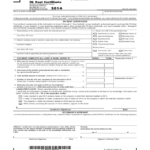Mn Renters Rebate Deposit Into Bank Account – If you rent your Minnesota home, you may qualify for a MN Renters Rebate. This property tax refund provides needed financial assistance to Minnesota families. Before you submit your application, there are many things you need to know. These include the deadlines and how much you are eligible to claim.
MN Renters’ Property Tax Refund
If you are renting a home, you may be eligible for a MN Renters’ Property Tax Refund. The government program offers a refund of up to 654 per household. The average refund is approximately $900. If a renter’s household income is below certain guidelines, they may be eligible for this refund.
You must have a valid social safety number or an individual tax identification number to be eligible. If you reside in a rental property, you can file. To file a claim, you have until August 15, 2023. The Department of Revenue provides information on refunds, including the Where’s My Refund tool.
Minnesota renters can receive a property tax refund depending on their income and number of dependents. This program is intended to help renters and homeowners who are unable to pay property taxes. Renters who live in nursing homes or assisted living facilities can also benefit from this program. Renters who live in Minnesota but are not residents of Minnesota may be eligible for a property refund.
MN M1PR returns are due by August 15. If you file your return within the deadline, you will receive a refund before the end of the calendar year. You may be able to get your refund quicker if you file your return electronically. The Minnesota Department of Revenue provides more information about the M1PR program and the refund process.
Deadlines to claim a refund
If you rent a property in Minnesota, you may be eligible to receive a refund of your property tax payments. The Minnesota Department of Revenue offers two refund programs for homeowners and renters. Each program is based on household income and property tax paid in the state. You can claim either program if you live in the state at least 183 days.
Minnesota renters can file for a refund by submitting Form M1PR and a Certificate of Rent Paid, which your landlord should have given you in January. You can also declare any additional income from nontaxable sources. Visit the Department of Revenue website to find out if your income qualifies for a refund.
The Minnesota Department of Revenue reminds homeowners and renters to file for their property tax refunds before the August 15 deadline. The refund season is for two years. Homeowners and renters who meet income requirements may claim up to $700 in property taxes. Renters who claim a refund typically receive about $654.
If you miss the August 15 deadline, you can still claim a refund by filing Form M1PR and waiting up to two weeks. You cannot get a refund for 2016 if you miss filing deadline.
Does income play a role in determining eligibility to a refund?
Minnesota renters are eligible for a partial refund of property taxes, as long as they meet certain income guidelines. In general, renters with incomes up to $62,960 qualify for a refund. Renters with incomes over this limit will receive a refund of up to 65 percent of the excess property tax amount. In other words, the average Minnesota renter will receive about $806 in return for paying nearly 40 percent of property tax.
Minnesota’s renters refund program provides tax relief for low- and moderate-income households. The program also benefits Black and Hispanic families, which are particularly affected by systemic racism and economic hardship. These groups are therefore disproportionately affected when property taxes rises.
Make sure to include information about roommates on your lease. You may also be eligible for an advance premium tax credit if you are a student. Make sure you list all roommates on your lease, as well.
Minnesota renters refunds are intended for Minnesota residents, but out-of-state residents can also qualify for the Minnesota Renters Property Tax Refund. The tax credit is based upon your household income and Minnesota property taxes paid.






